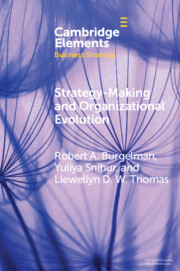Element contents
Strategy-Making and Organizational Evolution
Published online by Cambridge University Press: 06 March 2023
Summary
Keywords
- Type
- Element
- Information
- Series: Elements in Business StrategyOnline ISBN: 9781108987684Publisher: Cambridge University PressPrint publication: 23 March 2023
References
- 12
- Cited by

